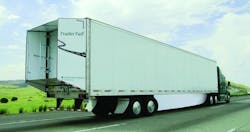NASHVILLE. The fuel saving potential of trailer aerodynamic devices for dry van trailers, from side skirts to “boat tails,” is all over the map according to a new report by the North American Council for Freight Efficiency (NACFE).
Yet there are other potentially valuable benefits to dry van trailer aerodynamic systems beyond just fuel economy improvements, the group noted, namely improving tractor-trailer stability, reducing rollover, decrease “splash and spray” in wet weather, while helping reduce driver fatigue in an anecdotal fashion due to improved stability reducing the need for lane corrections.
“We found that no one size fits all when it comes to trailer aerodynamics,” explained Mike Roeth, NACFE’s executive director, during a press conference here at the 2016 Technology & Maintenance Council (TMC) annual meeting.
“We also found that the correlation between wind tunnel and test track [fuel economy] results and the real world is not apples-to-apples,” he added. “We found anywhere for a third to a one-half variation in EPA SmartWay tests [using trailer aerodynamics] compared to real world operation simple because there are more variables.”
NACFE’s research found that the per-vehicle fuel economy benefit of trailer aerodynamic devices ranges from 1% to over 10%, depending on the devices chosen. Yet while there offer potentially significant fuel economy benefits, they can be “complicated to adopt” and can sometimes involve drawbacks, such as added weight, Roeth stressed.Yet those “drawbacks” don’t affect all equally fleets, argued Rick Mihelic, the author of the report and head of Mihelic Vehicle Consulting.
“Simple things such as direction and location affect the benefits,” he said. “For example, a fleet operating typically North-South will experience different wind patterns than a fleet operating East-West.”
NACFE’s report noted that the main challenges preventing more widespread adoption of trailer aerodynamic devices include: added weight; complicated and difficult-to-compare performance testing methods to gauge potential fuel savings; and the need to optimize tractor-trailer ratios.
“If you a fleet has a three-to-one trailer to tractor ratio, that means the trailer will be getting a third of the miles the tractor does, making payback challenging,” Roeth said.
Fleets also get the “greatest benefit” from adopting multiple aerodynamic devices, but as the net benefits from the package of devices do not simply equal the sum of each individual device, NACFE’s report noted, making it difficult for fleets to prioritize investment decisions and feel confident in achieving payback.
The low price of diesel fuel is also lengthening payback periods as well, Roeth added.“In 2014, when diesel was around $3.85 to $4 per gallon, a typical tractor trailer in long-haul operation consumed $70,000 in fuel per year” with 100,000 annual miles as a rough rule of thumb, he said.
“Here we are today and fuel costs half of that now, so that fuel expense has dropped to $36,000 per year,” Roeth noted.
Still, despite those issues, the fuel savings potential is there, NACFE pointed out, trumping even the weight issue.
The impact of weight on fuel economy is 0.5% to 0.6% per 1,000 lbs., NACFE said, and its study found that even the most aggressive aerodynamic fairings for trailers add less than 2,000 lbs. Thus the maximum mile-per-gallon reduction due to the weight of aerodynamic fairings would be less than 1.2% – much less than the 9%-plus potential gains in fuel economy at the high end for dry van trailer aerodynamic systems.
NACFE’s report also noted that trailer aerodynamic packages are aimed at addressing three distinct areas, with some seeing more popularity among trucking fleets than others:
- Underbody: Trailer skirts are the most popular devices for addressing drag and account for 30 to 40 ages of NACFE’s 100 page report. All trailer underbody skirts serve to extend the trailer side walls much closer to the ground, the group said, preventing wind from ducking in under the trailer and running into the non-aerodynamic trailer bogie. Trailer skirts offer 1% to more than 5% fuel savings versus non-skirted trailers, NACFE added, and nearly 30% of trailers are equipped with skirts today.
- Rear: So called “boat tail” or “wake devices” are rear-mounted and modify the air flow as it leaves the trailing edge of the side and top surfaces of the trailer. The goal in all rear trailer devices is to reduce the wake field following the trailer, which can affect air some distance from the back of the trailer. Some 5% of trailers today feature such devices.
- Gap: Tractor-to-trailer gap management devices are relevant only for a subset of the industry, NACFE found, as today’s more highly aerodynamic tractors have largely reduced their importance. However, many older tractor and daycabs, which require a higher tractor-to-trailer gap for maneuverability, would still benefit from devices that address drag created by that gap.
“What we’ve learning in our fuel efficiency research is that nothing is every simple; there are more benefits and challenges than meet the eye,” Roeth said. “A good portion of the fuel economy improvements we’ve experienced since 2014 are coming from the engine, about 40%. But that still leaves a lot of room for improvements outside the engine. There remain opportunities.”





